Abstract
Breath analysis is a non-invasive technique used in clinical laboratories for the identification of several morbid conditions. Renal failure patients can be distinguished by observing the degree of ammonia in exhaled breath. Standard treatment for renal failure patients is haemodialysis. Ammonia as a biomarker can also provide the efficiency of dialysis. This study proposes a system that uses metal oxide semiconductor sensors, which is capable of detecting ammonia from exhaled breath and identify whether the patient has been subjected to renal failure. Breath samples are gathered using a specially designed breath collecting tube and the steady-state responses are recorded after the samples have been passed through sensors TGS2444, MQ135, MQ137, and TGS826. From the steady-state response, geometric features are extracted and the support vector machine technique is used for classifying the pre- and post-dialysis groups. The results shown an accuracy of 88 % for the designed classifier for sensor TGS2444.






Similar content being viewed by others

References
Timmer, B., Olthuis, W., & Van Den Berg, A. (2005). Ammonia sensors and their applications a review. Sensors and Actuators, B: Chemical Sensors and Materials, 107, 666–677.
Amin, N., Mohamood, R. T., Asad, M. J., Zafar, M., & Raja, A. M. (2014). Evaluating urea and creatinine levels in chronic renal failure pre and post dialysis: A prospective study. Journal of Cardiovascular Disease, 2, 2.
Shamsadini, S., Darvish Moghaddam, S., Abdollahi, H., Fekri, A. R. & Ebrahimi H. A. (2006). Creatinine, blood urea nitrogen and thyroid hormone levels before and after haemodialysis. Eastern Mediterranean Health Journal, 12, 231–235.
Kumar, Gaurav, Mishra, Sunita, & Jain, Aastha. (2013). Development of breath ammonia analysis system for disease diagnosis. Asian Journal of Biochemical and pharmaceutical Research, 3, 36–43.
Distante, C., Leo, M., Siciliano, P., & Persaud, K. C. (2002). On the study of feature extraction methods for an electronic nose. Sensors and Actuators B Chemical Sensors and Materials, 87, 274–288.
Guo, D., Zhan, D., Li, N., Zhang, L., & Yang, J. (2010). A Novel breath analysis system based on electronic olfaction. IEEE Transactions on Biomedical Engineering, 11, 2753–2763.
Jayasree, T., & Muttan, S. (2014). Study of Gas sensors for the detection of Volatile organic compounds in breath. Applied Mechanics and Materials, 573, 785–790.
Jayasree, T., Bobby, M. & Muttan, S. (2015). Sensors for detecting Ammonia from the Exhaled breath of renal disorder patients. Sensor Letters, 13, 1–6.
Carmel, L., Levy, S., Lancet, D., & Harel, D. (2003). A feature extraction method for chemical sensors in electronic noses. Sensors and Actuators B Chemical Sensors and Materials, 93, 67–76.
Noori, M. N., Cao, Y., Hou, Z., & Sharma, S. (2010). Application of support vector machine for reliability assessment and structural health monitoring. International Journal of Engineering Under Uncertainty Hazards, Assessment and Mitigation, 2, 89–98.
Watanachaturaporn, P., Arora, M. K., & Varshney, P. K. (2008). Multisource classification using support vector machines: An Empirical comparison with decision tree and Neural network classifiers. Photogrammetric Engineering & Remote Sensing, 74, 239–246.
Mountrakis, G., Im, J., & Ogole, C. (2011). Support vector machines in remote sensing: A review. ISPRS Journal of Photogrammetry and Remote Sensing, 66, 247–259.
Zhou, X., Wu, Y., & Yang, B. (2010). Signal classification method based on support vector machine and higher-order cumulants. Wireless Sensor Network, 2, 48–52.
Li, Y., & Wen, P. P. (2011). Clustering technique-based least square support vector machine for EEG signal classification. Computer Methods and Programs in Biomedicine, 104(3), 358–372.
Wanfu, X., & Yaping, C. (2014). Study on detection and identification of gas sensor based on chromatographic separation. Sensors & Transducers, 176, 21–26.
Rabee, A. & Barhumi, I. (2012). ECG signal classification using Support Vector Machine Based on Wavelet Multi resolution analysis. Proceedings of the IEEE international. conference on information sciences, signal processing and their applications (Vol. 11, pp. 1319–1323).
Li, S. & Li, N. (2011). Breath ammonia analysis for the purpose of dialysis efficiency evaluation. Proceedings of the IEEE international conference biomedical engineering and informatics (Vol. 4, pp. 671–675).
Pechenizkiy, M. (2005). The impact of feature extraction on the performance of a classifier: kNN, Naïve Bayes and C4.5.In Canadian conference on AI, LNAI 3501 (pp. 268–279).
Acknowledgments
The writers recognize the doctors of the Nephrology Department of Rajiv Gandhi General Hospital/Madras Medical College and all the workers for giving their samples.
Author information
Authors and Affiliations
Corresponding author
Rights and permissions
About this article
Cite this article
Jayasree, T., Bobby, M. & Muttan, S. Sensor Data Classification for Renal Dysfunction Patients Using Support Vector Machine. J. Med. Biol. Eng. 35, 759–764 (2015). https://doi.org/10.1007/s40846-015-0098-4
Received:
Accepted:
Published:
Issue Date:
DOI: https://doi.org/10.1007/s40846-015-0098-4



